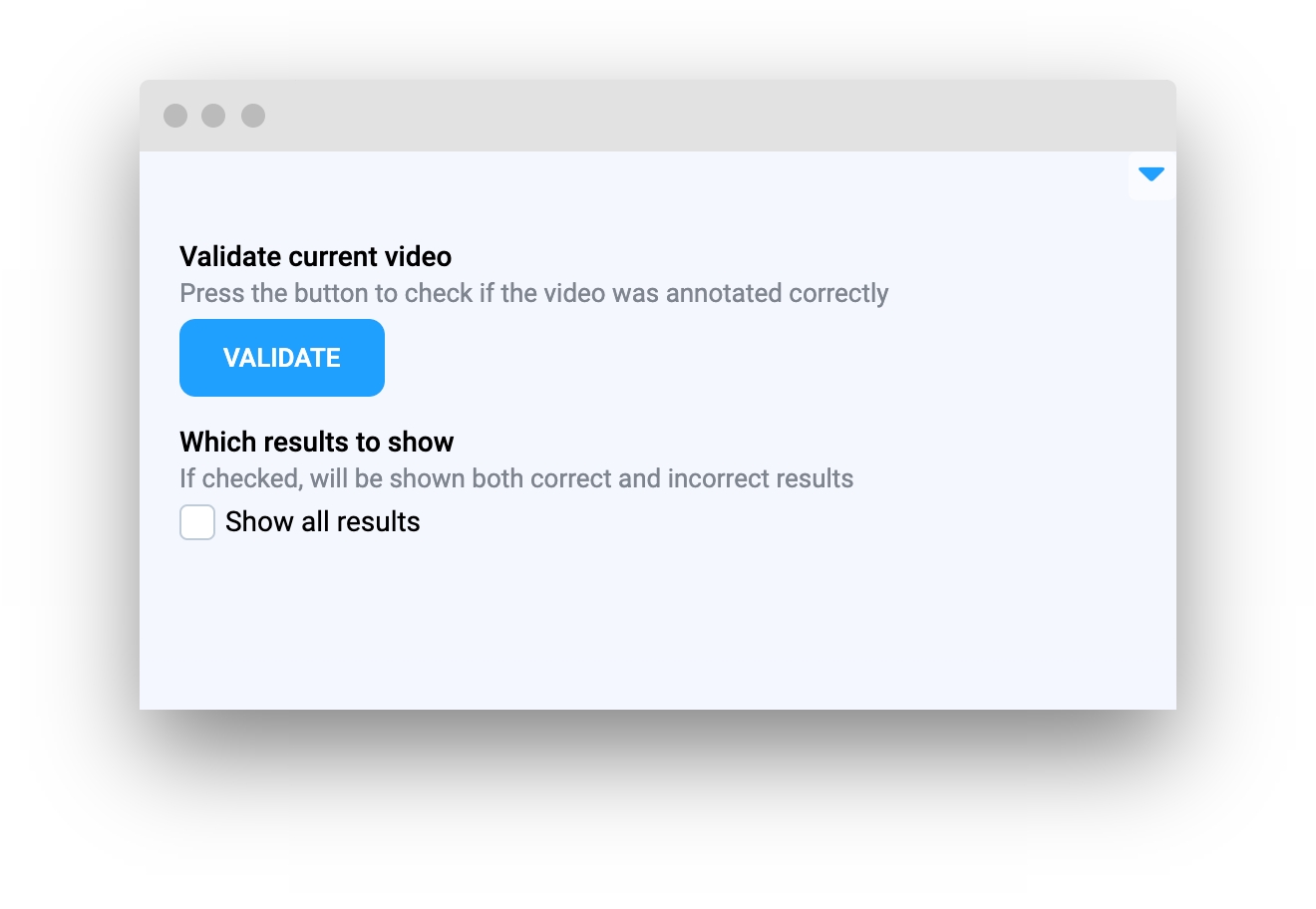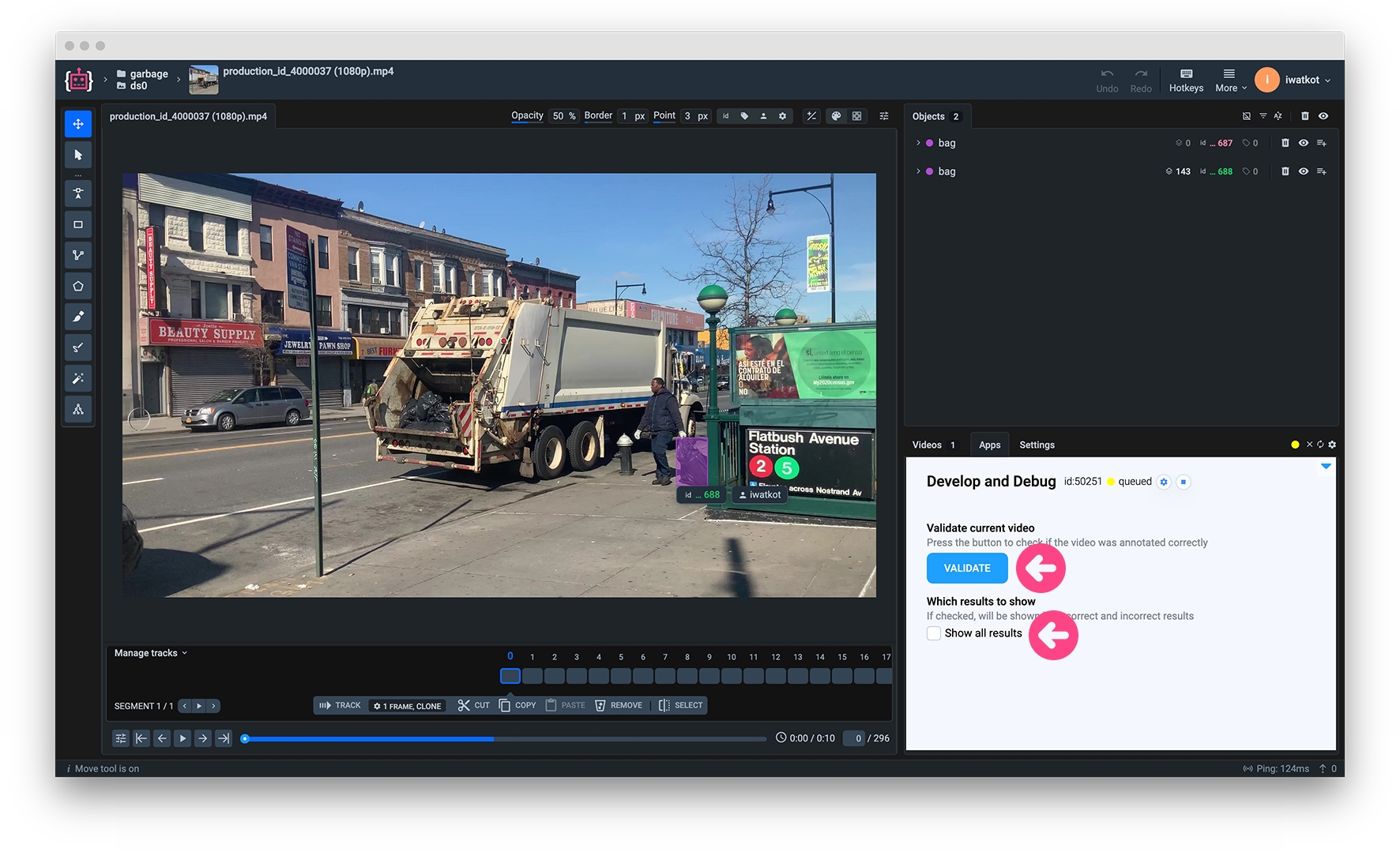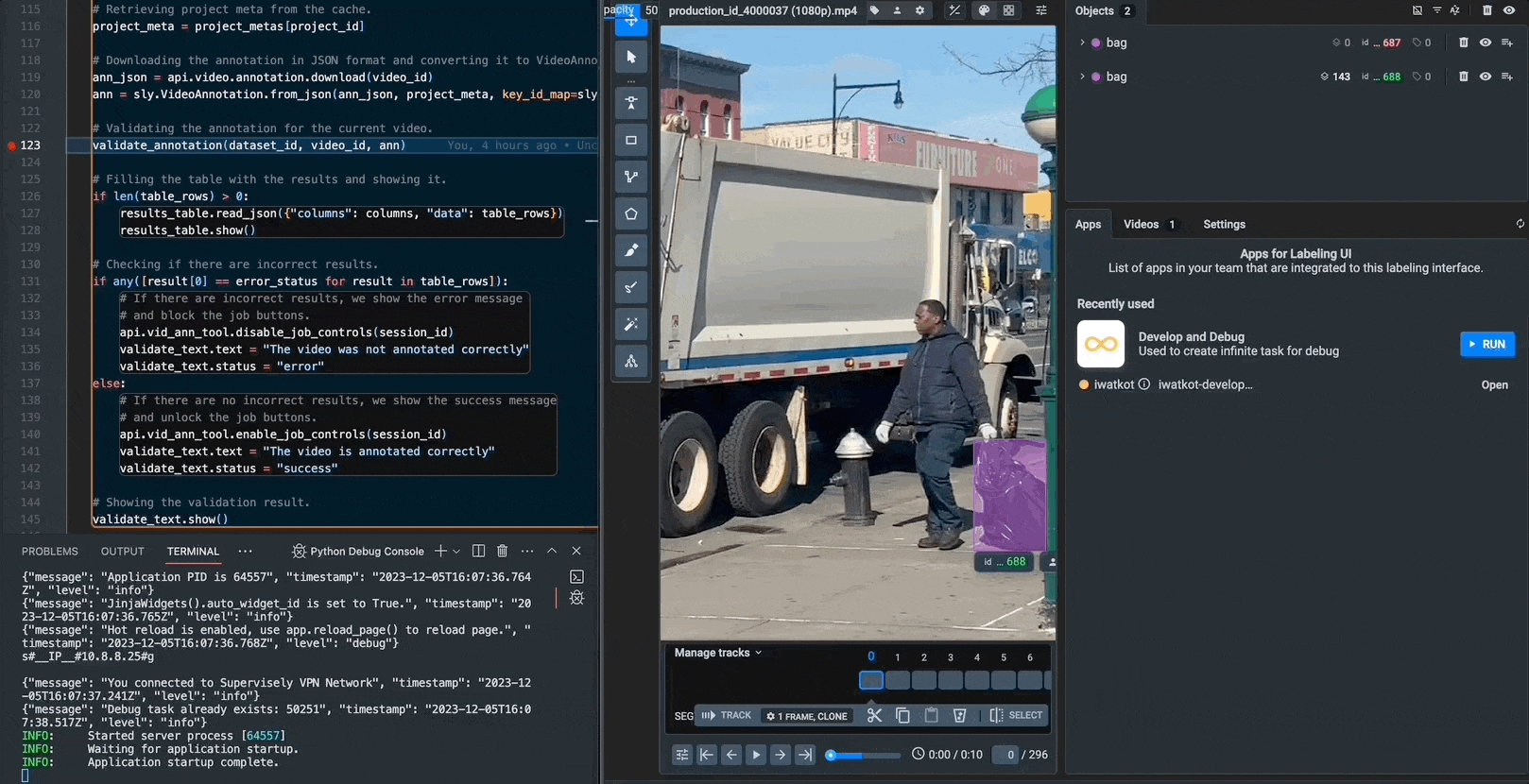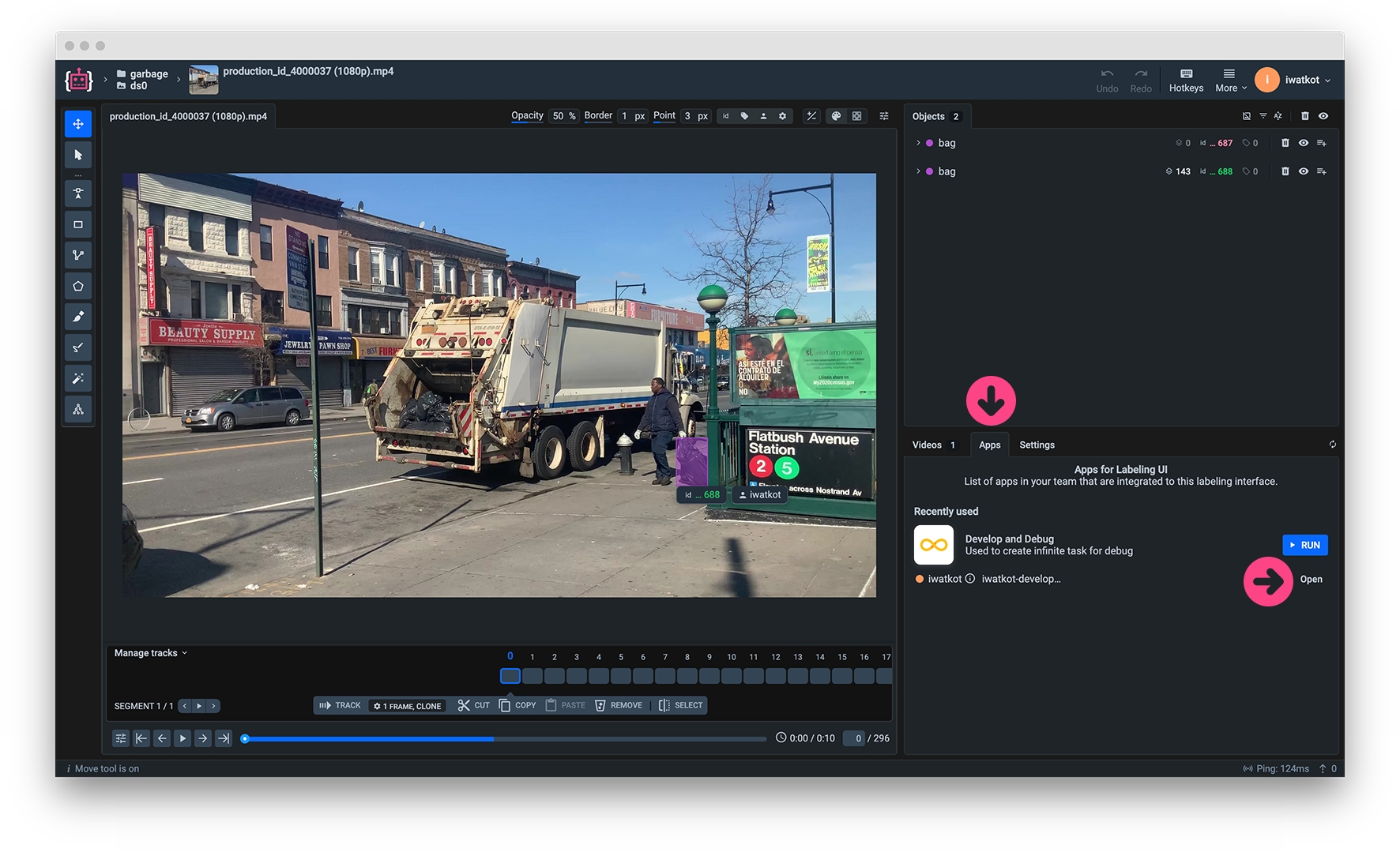App in the Video Labeling Tool
Introduction
Developing a custom app for the Labeling Tool be useful in the following cases:
When you need to combine manual labeling and the algorithmic post-processing of the labels in real-time.
When you need to validate created labels for some specific rules in real-time.
When you need to disable / enable some actions for the labeler (e.g. Submitting the job, etc.) if the created labels do not meet some specific rules.
In this tutorial, we'll learn how to develop an application that will validate the created labels for specified rules by clicking on the Validate button. You can implement your logic for the validation of the labels, but here now we'll use the following rules:
First, we create a tag on the video for a range of frames.
Then, we assign a value to the tag with the name of an object class, where the object with the same class name must be present at least in one frame of the range.
When the application is started it will disable the buttons
Confirmfor the video and theSubmit jobfor the labeling job.When the
Validatebutton is clicked, the application will check the labels for the conditions above and enable the buttonsConfirmandSubmit jobif the conditions are met, otherwise, the buttons will be disabled.
Our application will show the results of the validation in the table, where each row will contain the following information:
Status (correct or incorrect).
Button to jump to the frame range in the video (where an object should be present).
Object class name.
Frame range.
The most important thing about this table are buttons in the Go to Frame column. When you click on the button, the video will jump to the frame range in the same browser tab. It's a very convenient way to check the labels and the video at the same time.
We will go through the following steps:
Step 1. Implement UI
But first, we need to import required packages and modules:
To be able to change the app's settings we need to add UI widgets to the app's layout. So, we'll need the following widgets:
Button to start the validation of the labels.
Table to display the validation results.
Checkbox to enable / disable showing all results (including the correct ones).
Text to show the overall validation result. (optional, just for better UI)
Field widget to add title and description to the UI section. (optional, just for better UI)
As you can see, we're using the hide() method for the widgets that we don't want to show at the start of the application. Since there are no results yet, we don't need to show the table and the text with the overall result. Later, we'll use the show() method to show the widgets when we need them.
Now, our widgets are ready and we can create the app's layout:
Right now our UI is ready and we can check how it looks just by running the app locally. It's a convenient way to check if everything is ok with the UI before moving to the next steps. The repository with the source code already contains the .vscode directory with the launch.json file, so you can just run the app from VSCode by hitting F5 or by clicking Run and Debug in the Debug section.
In the screenshot above you can see how the app looks when it's running locally. It's not yet integrated into the Labeling Tool, we'll do it a little bit later and obviously, it would not work, since it's not linked to the Video Labeling Tool, so we just check the UI and make sure that everything is ok with it.
Step 2. Enabling Integrated Debug Mode
Step 3. Handling the events
Now, we need to handle the events that will be triggered by the Labeling Tool. In this tutorial, we'll be using only one event, when the current video has changed. It also will be triggered when the application is launched for the first time. This event is needed for the app, so it will be able to get the current video and its labels.
That's it! Our function will receive the API object and the Event object and that's all we need to process the mask. The API object contains credentials for the user, which is currently working in the Labeling Tool and triggered the event. The Event object contains a lot of context information, such as:
So it will be easy to get any required information from the Event object like this:
and so on.
As you can see, the event object contains all the required information, so validation in the tutorial is just one example of what you can do with your application. That means that you can also do some other stuff, for example, process the labels or copy the video to another project, etc. So, your app can do anything you want.
Step 4. Preparing the config.json file
So, it will allow us to run the application directly in the Video Labeling Tool.
Step 5. Using cache (optional)
So, if we already have the project meta in the cache, we don't need to download it again. But if we don't have it, we need to download it and add it to the cache.
Step 6. Reading information from the event
Now, we need to get the required information from the event object and save it in global variables, so we can use it later, when the Validate button is clicked.
And now the full code of the video_changed function:
As you can see in the code above, we're also disabling the buttons Confirm for the video and the Submit job for the labeling job using the disable_job_controls method. We need to do it because we don't want the user to be able to submit the job or confirm the video until the validation is completed. So buttons will be disabled any time the video is changed or when the application is launched for the first time.
Step 7. Preparing the validation function
Ok, we've got the required information from the event, now we need to prepare the function that will validate the labels. But this function should be called when the Validate button is clicked. And we'll use a convenient decorator for this.
Let's take a closer look at the validate_video function:
We clear the table and hide it because we will fill the table with new results. We also hide the error message from the previous validation and will show it again if there are incorrect results.
Then we retrieve the project meta from the cache.
Downloading the annotation in JSON format and converting it to the
VideoAnnotationobject.Then we validate the annotation for the current video using the
validate_annotationfunction, which is described below.Then we fill the table with the results and show it if there are any results.
Then we check if there are incorrect results. If there are, we show the error message and block the job buttons. Otherwise, we show the success message and unlock the job buttons.
And finally, we show the validation result.
So now it's time to implement the validate_annotation function.
Step 8. Implementing the annotation validation function
Just to remind you how we will validate the annotation:
We check the annotation for the presence of the tags.
We read the tag value, which is supposed to be the name of the object class and the frame range.
We check if the object with the same class name is present in at least one frame of the range.
After that, we'll need to fill the table with the results. Let's now implement the validate_annotation function:
Since we will check the annotation for each tag, we will iterate over all tags in the current annotation and it's better to use another function for this. That's why we've created the is_in_range() function. It will check if there's an object with the same ObjClass name as a value of the current tag in the tag's frame range. If there is, it will return True, otherwise False.
Then we'll use this function in the validate_annotation() function. It will iterate over all tags in the current annotation and check them using the is_in_range() function. But let's check what the validate_annotation() function does in more detail:
Iterating over all tags in the current annotation.
Calling the
is_in_range()function to check if there's an object with the same ObjClass name as a value of the current tag in the tag's frame range.Depending on the result of the
is_in_range()function, we'll set the status of the result to values of theok_statusorerror_statusvariables.Then we'll prepare an entry for the results table, which is just a list of values for each column in the table.
We also check if we need to show all results or only incorrect ones. If we need to show all results, we'll add the result to the table, otherwise, we'll add only incorrect results.
And that's it. Now table rows are saved in the table_rows variable and we can fill the table with them. And it will be done in the validate_video() function. And our application is ready, let's test it!
Step 9. Running the app locally
Now, when everything is ready let's run the app and test it in the Labeling Tool. After launching the app from your VSCode you'll need to enter your root password to run the VPN connection. If everything works as it should, you'll see the following message in the terminal:
Now follow the steps below to test the app while running it locally:
Open Video Labeling Tool in Supervisely.
Select the
Appstab.Find the
Develop and Debugapplication with a running marker and clickOpen.The app's UI will be opened in the right sidebar.
The application UI including the widgets we created earlier is displayed in the right sidebar. The buttons Confirm for the video and the Submit job for the labeling job are disabled already. Just a reminder: you need to open the actual labeling job to see those buttons, if you will open a video through the Datasets tab, you won't see those buttons.
So, now we can start testing the app. But before ensure that you've already created some tags in range of frames for the current video with values that are the same as the object class names. Otherwise, the app will have nothing to validate and the result will always be The video is annotated correctly.
Let's also check that our Checkbox widget is working correctly:
Check the
Show all resultscheckbox.Click the
Validatebutton.You should see all the results in the table (both correct and incorrect).
Also, let's try to click on the Open button to jump to the exact frame in the video, where the object with the same class name is present. It should work correctly too.
Step 10. Releasing the private app and running it in Supervisely
After it's done, you can find your app in the Apps section of the platform and run it in the Labeling Tool without running the code locally. The steps are the same as in the previous step, but this time we'll be launching the actual application. In this tutorial the app's name in config.json is Video Labeling Tool template, so we'll find it in the list and click Run.
Summary
In this tutorial, we've learned how to develop a custom app for the Video Labeling Tool. We've learned how to use the UI widgets, how to handle the events, how to read information from the event, how to validate the annotation and show the results in the table. We also learned how to use Integrated Debug Mode and how to release the app and run it in Supervisely. We hope that this tutorial was helpful for you and you'll be able to use it as a reference for your application.
Last updated
Was this helpful?



